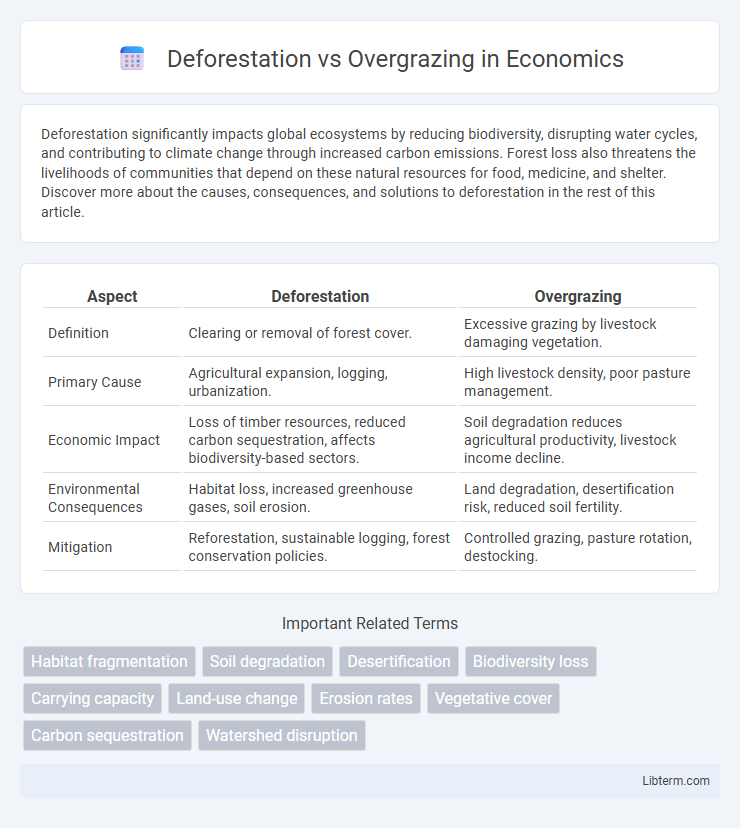Deforestation significantly impacts global ecosystems by reducing biodiversity, disrupting water cycles, and contributing to climate change through increased carbon emissions. Forest loss also threatens the livelihoods of communities that depend on these natural resources for food, medicine, and shelter. Discover more about the causes, consequences, and solutions to deforestation in the rest of this article.
Table of Comparison
| Aspect | Deforestation | Overgrazing |
|---|---|---|
| Definition | Clearing or removal of forest cover. | Excessive grazing by livestock damaging vegetation. |
| Primary Cause | Agricultural expansion, logging, urbanization. | High livestock density, poor pasture management. |
| Economic Impact | Loss of timber resources, reduced carbon sequestration, affects biodiversity-based sectors. | Soil degradation reduces agricultural productivity, livestock income decline. |
| Environmental Consequences | Habitat loss, increased greenhouse gases, soil erosion. | Land degradation, desertification risk, reduced soil fertility. |
| Mitigation | Reforestation, sustainable logging, forest conservation policies. | Controlled grazing, pasture rotation, destocking. |
Introduction to Deforestation and Overgrazing
Deforestation involves the large-scale removal of trees, leading to habitat loss, reduced biodiversity, and disrupted carbon cycles. Overgrazing occurs when livestock feed excessively on vegetation, degrading soil quality and accelerating erosion. Both processes contribute significantly to land degradation and environmental imbalance.
Causes of Deforestation
Deforestation primarily results from agricultural expansion, logging for timber and fuelwood, and infrastructure development such as road construction and urbanization. Commercial agriculture, particularly large-scale monocultures like soy and palm oil plantations, drives significant forest clearance. Illegal logging and land conversion for mining also contribute heavily to forest loss, disrupting biodiversity and carbon storage.
Causes of Overgrazing
Overgrazing occurs when livestock consume vegetation faster than it can naturally regenerate, leading to soil degradation and reduced plant biodiversity. Key causes include excessive stocking rates, prolonged grazing periods without proper rotation, and poor land management practices. This results in diminished soil fertility, increased erosion, and the loss of habitat for native species.
Environmental Impacts of Deforestation
Deforestation leads to significant environmental impacts, including loss of biodiversity, disruption of water cycles, and increased greenhouse gas emissions due to reduced carbon sequestration. Overgrazing primarily causes soil degradation and desertification, but deforestation has a broader ecological footprint by eliminating critical habitats and accelerating climate change. The removal of forest cover intensifies erosion, decreases soil fertility, and compromises ecosystem services vital for human and wildlife survival.
Environmental Impacts of Overgrazing
Overgrazing leads to severe soil erosion, reducing land fertility and disrupting local ecosystems by removing protective vegetation cover. It contributes to desertification by degrading grasslands and reducing biodiversity, which impairs carbon sequestration and intensifies climate change effects. The loss of plant roots destabilizes soil structure, increasing runoff and sedimentation in water bodies, affecting water quality and aquatic habitats.
Effects on Biodiversity: Deforestation vs Overgrazing
Deforestation causes habitat loss, fragmentation, and a significant decline in species diversity by removing large areas of forest that support complex ecosystems. Overgrazing leads to soil degradation, reduced plant cover, and altered vegetation composition, which diminishes food resources and shelter for wildlife, negatively impacting biodiversity. Both processes disrupt ecological balance, but deforestation typically results in more immediate and extensive loss of species compared to the often gradual effects of overgrazing.
Socioeconomic Consequences
Deforestation accelerates soil erosion, reducing agricultural productivity and increasing vulnerability to food insecurity in rural communities heavily dependent on forest resources. Overgrazing depletes vegetation cover, leading to land degradation and diminished pasture quality, which directly impacts the livelihoods of pastoralists and small-scale farmers. Both processes contribute to economic instability, displacement, and increased poverty, exacerbating social inequalities in affected regions.
Climate Change: How Both Contribute
Deforestation accelerates climate change by releasing stored carbon dioxide through tree removal, reducing the Earth's capacity to absorb greenhouse gases. Overgrazing depletes vegetation cover, leading to soil degradation and diminished carbon sequestration, which exacerbates atmospheric carbon levels. Both processes disrupt local and global climate patterns by increasing greenhouse gas concentrations and altering land surface albedo.
Prevention and Mitigation Strategies
Deforestation prevention strategies include enforcing sustainable logging practices, reforestation programs, and promoting agroforestry to restore ecosystem balance. Overgrazing mitigation involves rotating livestock grazing areas, implementing controlled grazing systems, and restoring degraded lands with native vegetation. Both approaches emphasize community engagement and policy enforcement to ensure long-term land productivity and biodiversity conservation.
Conclusion: Key Differences and Solutions
Deforestation primarily involves the removal of trees, leading to habitat loss and diminished carbon sequestration, while overgrazing results in soil degradation and reduced vegetation cover due to excessive livestock feeding. Effective solutions for deforestation include reforestation programs and sustainable logging practices, whereas overgrazing can be mitigated through controlled grazing, rotational pastures, and improved livestock management. Addressing both requires integrated land-use planning that balances environmental conservation with agricultural needs.
Deforestation Infographic

 libterm.com
libterm.com